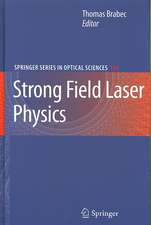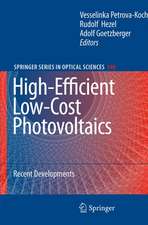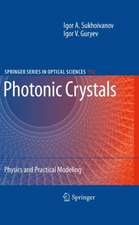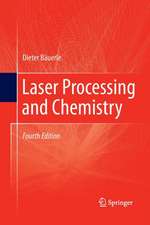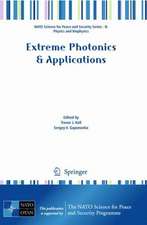Introduction to Liquid Crystals
Autor E. Priestlyen Limba Engleză Paperback – 26 mar 2012
Preț: 391.40 lei
Nou
Puncte Express: 587
Preț estimativ în valută:
74.90€ • 77.38$ • 62.34£
74.90€ • 77.38$ • 62.34£
Carte tipărită la comandă
Livrare economică 25 martie-08 aprilie
Preluare comenzi: 021 569.72.76
Specificații
ISBN-13: 9781468421774
ISBN-10: 1468421778
Pagini: 372
Ilustrații: XII, 356 p.
Dimensiuni: 152 x 229 x 20 mm
Greutate: 0.49 kg
Ediția:1975
Editura: Springer Us
Colecția Springer
Locul publicării:New York, NY, United States
ISBN-10: 1468421778
Pagini: 372
Ilustrații: XII, 356 p.
Dimensiuni: 152 x 229 x 20 mm
Greutate: 0.49 kg
Ediția:1975
Editura: Springer Us
Colecția Springer
Locul publicării:New York, NY, United States
Public țintă
ResearchCuprins
1 Liquid Crystal Mesophases.- 1. Mesophases.- 2. Types of Liquid Crystals.- 3. Classification According to Molecular Order.- 4. Polymorphism in Thermotropic Liquid Crystals.- 5. Molecular Structure of Thermotropic Mesogens.- 6. Properties of Ordered Fluid Mesophases.- 2 Structure-Property Relationships in Thermotropic Organic Liquid Crystals.- 1. Introduction.- 2. Organic Mesophases.- 3. General Structural Features of Mesogens.- 4. Effects of Structure on Mesophase Thermal Stability.- 5. Homologous Series.- 6. Materials for Device Applications.- 7. Summary.- 3 Introduction to the Molecular Theory of Nematic Liquid Crystals.- 1. Introduction.- 2. Symmetry and the Order Parameter.- 3. The Molecular Potential.- 4. The Orientational Distribution function.- 5. Thermodynamics of the Nematic Phase.- 6. Fluctuations at Tc.- 4 Generalized Mean Field Theory of Nematic Liquid Crystals.- 1. Introduction.- 2. The Pair Interaction Potential.- 3. The Mean Field Approximation.- 4. Statistical Thermodynamics.- 5. Nature of the Parameters UL.- 6. The Need for Higher Order Terms in V1.- 5 Hard Rod Model of the Nematic-Isotropic Phase Transition.- 1. Introduction.- 2. Derivation of Onsager Equations.- 3. Solution of Onsager Equations in a Simplified Case.- 6 Nematic Order: The Long Range Orientational Distribution Function.- 1. Introduction.- 2. The Orientational Distribution function.- 3. Macroscopic Definition of Nematic Order.- 4. Relationship Between Microscopic and Macroscopic Order Parameters.- 5. Experimental Measurements.- 6. Experimental Data.- 7 Introduction to the Molecular Theory of Smectic-A Liquid Crystals.- 1. Introduction.- 2. Symmetry, Structure and Order Parameters.- 3. Phase Diagrams.- 4. The Molecular Potential.- 5. Statistical Thermodynamics.- 6. Numerical Results.- 7.Improved Theory.- 8. The Possibility of Second-Order Transitions.- 8 Introduction to the Elastic Continuum Theory of Liquid Crystals.- 1. Introduction.- 2. The Fundamental Equation of the Continuum Theory of Liquid Crystals.- 3. Applications of the Elastic Continuum Theory.- 4. Concluding Remarks.- 9 Electrohydrodynamic Instabilities in Nematic Liquid Crystals.- 1. Introduction.- 2. Nature of the Instability and the Balance of Forces.- 3. Dielectric Response.- 4. Hydrodynamic Effects.- 5. The Boundary Value Problem in the Conduction Regime.- 6. The Torque Balance Equation.- 7. Numerical Results and Comparison with Experiment.- 8. Range of Applicability.- 10 The Landau-de Gennes Theory of Liquid Crystal Phase Transitions.- 1. Introduction.- 2. Derivation of the Fundamental Equations of the Landau-de Gennes Theory.- 3. Thermodynamic Properties of Liquid Crystal Phase Transitions.- 4. Fluctuation Phenomena.- 5. Observation of Fluctuations Using Light Scattering.- 6. Magnetic Birefringence and the Paranematic Susceptibility.- Appendix A.- Appendix B.- 11 Introduction to the Optical Properties of Cholesteric and Chiral Nematic Liquid Crystals.- 1. Introduction.- 2. Maxwell’s Equations.- 3. Discussion.- 4. Conclusion.- Appendix A.- Appendix B.- 12 Liquid-Crystal Displays—Packaging and Surface Treatments.- 1. Introduction.- 2. Packaging.- 3. Electrodes.- 4. Surface Orientation.- 5. Influence of Packaging on Surface Orientation.- 6. Summary.- 13 Pressure Effects in Sealed Liquid-Crystal Cells.- 1. Introduction.- 2. Effect of Temperature Change.- 3. Effect of Glass Thickness.- 4. The Case of a Rigid Container.- 14 Liquid-Crystal Displays—Electro-optic Effects and Addressing Techniques.- 1. Introduction.- 2. Electro-optic Phenomena.- 3. Display-Related Parameters.- 4.Addressing Techniques.- 5. Summary.- 15 Liquid-Crystal Optical Waveguides.- 1. Introduction.- 2. Guided Optical Waves.- 3. Phase Matching and Coupling.- 4. Scattering.- 5. Liquid Crystal Waveguides.- 6. Conclusions.- 16 The Electro-optic Transfer Function in Nematic Liquids.- 1. Introduction.- 2. Geometrical Considerations in Optical Measurements.- 3. Field Effects—Negative Dielectric Anisotropy.- 4. Field Effects—Positive Dielectric Anisotropy.- 5. Hydrodynamic Effects—Diffraction by Domains.- 6. Dynamic Scattering.- 7. Photoconductor Control.- 17 Electrochemistry in Nematic Liquid-Crystal Solvents.- 1. Introduction.- 2. Equilibrium Properties of Bulk Solutions.- 3. Electrochemical Reactions.- 18 Lyotropic Liquid Crystals and Biological Membranes: The Crucial Role of Water.- 1. Introduction.- 2. Lyotropic Liquid Crystals.- 3. Biological Membranes.- 4. Interaction of Amphiphilic Compounds with Water.- 5. Conclusion.




